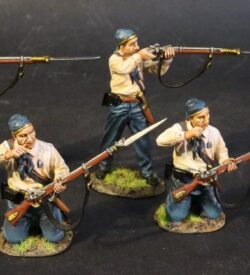CS33V-03 Standard Bearer, 33rd Virginia Infantry Regiment
$70.00
Description
The 33rd Virginia Infantry Regiment was raised in the commonwealth of Virginia for service in the Confederate States Army and was part of the famed “Stonewall Brigade”.
When the Union and Confederate armies engaged near Manassas Junction, Virginia, on July 21st 1861, General Jackson and his brigade earned the nickname “Stonewall”. Eight of the ten companies in the 33rd were present.
By late May 1861, the regiment was placed under the command of Col. Arthur C. Cummings, who was a graduate of the Virginia Military Institute who practiced law in Abington, Virginia at the far southernmost end of the valley and would twice represent Washington County, Virginia in the Virginia House of Delegates (first beginning in 1863 and again in 1871).
At the height of the battle, it was Jackson’s first brigade, and more specifically, the undersized regiment of Colonel Cummings that turned the tide of battle with a well-timed charge against an exposed artillery battery.
The 33rd Virginia remained in the Stonewall Brigade in Thomas J. Jackson’s Second Corps until the restructuring of the Army of Northern Virginia after his death in the spring of 1863. It was placed under Richard Ewell’s command until the spring of 1864, when it dissolved following heavy losses at the Battle of Spotsylvania Court House.
The Emerald Guard was formed in and around the town of New Market during May and early June of 1861. It was organized by a thirty-four year old Shenandoah County native named Marion Marye Sibert. and as it’s name implied was formed from the Irish laborers that worked in the Valley when the War began. The company would become among the most colorful and volatile companies of the famed “Stonewall Brigade”. “In their adopted sector,” one historian would write, “the Sons of Erin did not mesh easily with their conservative neighbors, most of whom were of German and Scotch-Irish descent. The Celts’ predilection for hard liquor and their affinity for world-class brawling at the least provocation engendered a definite air of notoriety.
Many of the Irishmen who joined the unit in May and June of 1861 were thought to be laborers who had been engaged on the construction of the Manassas Gap Railroad.






